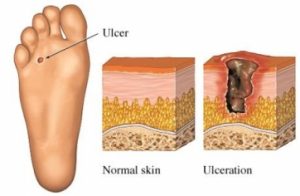Causes, Risk Factors, Prevention, and Treatment of Diabetic Foot Sores
Persistently high blood sugar levels can cause nerve damage commonly known as diabetic neuropathy. Although diabetic neuropathy can develop in any part of the body, it mostly occurs in the feet and legs. The condition typically causes loss of feeling in the feet and as a result it becomes difficult to notice a cut, sore, or blister. For instance, you might not notice pebbles in your socks that are cutting your feet. A wound that goes unnoticed and hence untreated can easily become infected.
Diabetes might also affect the flow of blood to the feet and legs. As a result, diabetes patients are more likely to develop PAD 9peripheral artery disease), a condition that narrows or blocks arteries. Poor circulation (reduced blood flow) can make it hard for diabetic foot sores or infections to heal.
 Diabetic foot sores and infections are common complications of poorly managed or unmanaged diabetes. Diabetes is managed through various methods including insulin treatment, exercise, and diet.
Diabetic foot sores and infections are common complications of poorly managed or unmanaged diabetes. Diabetes is managed through various methods including insulin treatment, exercise, and diet.
Foot sores as a result of the breakdown of tissue expose the delicate tissues underneath. Areas that are most commonly affected include the balls of your feet and your big toes, and they can damage your feet to the bones.
Diabetic foot sores can affect anyone but they can be easily prevented through good foot care. Treatment varies depending on the cause of the diabetic foot sores. Therefore, it is essential to discuss any foot concerns with your healthcare provider to ensure the problem is addressed, as infected sores can even result in serious complications including amputation if left untreated.
What are the causes of diabetic foot sores?
The most common causes of foot sores in diabetes patients include:
- Nerve damage
- Hyperglycemia (high blood sugar)
- Poor circulation
- Wounded or irritated feet
Poor circulation is one of the most common vascular diseases in which blood does not flow to the feet effectively. You should keep in mind that poor circulation makes it more difficult for foot sores, ulcers, and wounds to heal.
High blood sugar levels can also hamper the healing process of infected foot ulcers. Therefore, proper blood glucose management is extremely critical. People with ailments such as type 2 diabetes usually have a hard time fighting off infections including infections from foot sores.
Nerve damage is one of the long-term effects that can lead to loss of feeling in the feet. Moreover, damaged nerves tend to feel painful and tingly. Nerve damage also reduces sensitivity to pain and can easily cause painless wounds that cause foot sores.
Foot sores are usually identified by fluid drainage from affected areas and sometimes noticeable lumps that are not always painful.
Are you at risk of developing diabetic foot sores?
All diabetes patients are at risk of developing diabetic foot sores, which may have several causes. Factors that increase the risk of foot sores include:
- Poor quality or poorly fitted shoes
- Poor hygiene (Feet should be washed regularly and dried well)
- Untrimmed or poorly trimmed toenails
- Eye disease (typically from diabetes)
- Kidney disease
- Alcohol consumption
- Heart disease
- Tobacco use (can inhibit circulation)
- Obesity
Diabetic foot sores are also more common in older people especially men.
Signs of diabetic neuropathy
Symptoms of diabetic neuropathy include:
- Pain
- Darkening of the affected area and the surrounding skin
- Tingling
- Loss of hair in the area
- Diminished sensitivity to cold or hot
- Numbness
If diabetic neuropathy causes diabetic foot sores, some of the symptoms you should watch out for include:
- Changes to the toenails or skin, including sores, cuts, blisters or calluses
- Pain
- Discharge of pus or fluid
- Swelling
- Redness
- Foul smell
- Skin discoloration
Treatment for diabetic foot sores
Doctors may recommend off-loading (staying off your feet) which helps prevent pain from foot sores and has been proven to be helpful for all forms of foot sores caused by diabetes. Remember, pressure from activities such as walking can expand foot sores and make infections worse. You may also be prescribed certain items to reduce pain and protect your feet:
- Foot braces

- Shoe inserts (to prevent calluses and corns)
- Compression wraps
- Casts
- Shoes designed for diabetes patients
Preventive measures
Infection of diabetic foot sores can be prevented with:
- Disinfecting the area surrounding the sore
- Footbaths
- Frequent dressing changes to keep the sores dry
- Dressings to prevent bacteria growth
- Enzyme treatments
It is essential for people with diabetes to take proper care of their feet and keep their blood sugar levels within the recommended ranges to prevent diabetic foot sores and more serious complications such as hospitalization or amputation (to prevent the infection from spreading).

